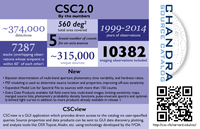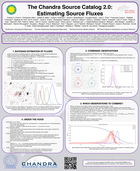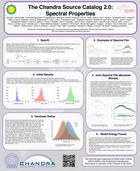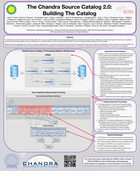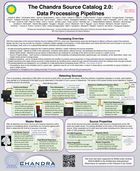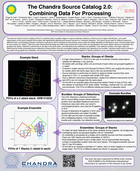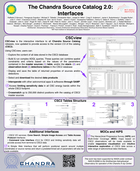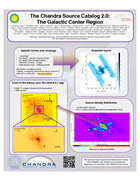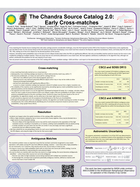231st Meeting of the American Astronomical Society
8 January 2018 - 12 January 2018
Washington, DC
Demos
The following demonstrations were shown at the CXC booth, with the CSC team members available for questions. Please use the CXC Helpdesk if you have any questions about CSC 2.
- Searching for sources near a position in CSCView (MP4, two minutes and 21 seconds)
- Performing a cross match between CSC 2.0 and a Vizier catalog (MP4)
- Send a light curve of a CSC 2.0 source to TOPCAT (MP4, two minutes 12 seconds)
- A demonstration of how data can be sent from CSCView to other aplications (TOPCAT and DS9) (MP4, 3 minutes 35 seconds)
223. Data Driven Discoveries in Serendipitous X-ray Catalogs
This session was on Wednesday, January 10, and from 2.00pm until 3.30pm in Maryland Ballroom C.
For the past ~17 years, Chandra and XMM Newton have been observing selected regions of the sky in the 0.5 - 10 keV band. These observations have resulted in a wealth of publications on targeted sources. Collectively, the observations cover 1800 deg2 of the sky with a total of 550 Ms of exposure time, resolving 100% of the cosmic XRB in point sources. These data have been mined by the Chandra and XMM-Newton teams to extract catalogs that include all of the serendipitous sources in the field of view of given targets, as well as the targets themselves. These catalogs include almost a million X-ray sources, in wildly different environments. Most of the catalog sources have not undergone specific investigation and represents, for this reason, an untapped reservoir of discovery that could shed new light on the X-ray Universe. Some of the questions we will seek to address are: What new can be learnt from an open ended exploration of the X-ray sky making use of these catalogs? What are the X-ray-specific diagnostics and exploration techniques that will open the field to new, unexpected discoveries? What challenges are posed by mining these X-ray catalogs in conjunction with other wavelength repositories? The speakers in this session will guide us through the XMM and Chandra catalogs, present the recently released Chandra Source Catalog version 2 (source properties, pipeline and public interfaces), talk about new ways to use the available datasets to address the above questions, and the synergies between X-rays and other wavelengths source catalogs (including SDSS, WISE, Pan-STARRS, etc). Moreover, we will include a discussion on how the studies on current catalogs can inform what can be done and planned in the near and far future with data from the upcoming large field, large collecting area X-ray telescopes (eRosita, Athena, Lynx, etc).
- 2:00 PM - 2:08 PM, 223.01. Doing Science with the Chandra Source Catalog,
-
The excellent spatial resolution (~1 arcsecond on-axis) of the Chandra X-ray Observatory, combined with a reasonable field of view and low instrumental backgrounds, allow detection of serendipitous X-ray sources with a high detectable-source density with low confusion. The aim of the Chandra Source Catalog (CSC) is to disseminate this wealth of information to the user community in a form that is immediately usable for scientific investigation, and the catalog is intended to satisfy the needs of a broad- based group of scientists, including those who may be less familiar with astronomical data analysis in the X-ray regime.
The second major release of the catalog, CSC 2.0, will be made available to the user community in early 2018, and preliminary lists of detections and sources are available now. CSC 2.0 will roughly triple the size of the current version of the catalog to an estimated 375,000 detections, corresponding to ~315,000 unique X-ray sources on the sky. For each detected X-ray source, the catalog provides a detailed set of properties including the source position and associated position error ellipse, source extent, multi-band aperture photometry probability density functions, spectral fits using several source models, hardness ratios, and intra- and inter-observation temporal variability measures. All numerical measures have associated two-sided confidence intervals. In addition to tabular data, the catalog provides FITS data products that are immediately suitable for further user analysis, including per-field and per-source images, photon event lists, responses, spectra, and light curves.
We describe the content and organization of the catalog in more detail, discuss the analyses that were performed to extract the measured source properties, and demonstrate how the catalog content can be immediately and effectively utilized for scientific investigations.
This work has been supported by NASA under contract NAS 8-03060 to the Smithsonian Astrophysical Observatory for operation of the Chandra X-ray Center.
- 2:08 PM - 2:16 PM, 223.02. Variable X-ray sources in the 3XMM catalogue,
-
The current version of the XMM-Newton serendipitous source catalogue, 3XMM-DR7, was released on 1st June 2017. It contains 727790 X-ray detections, of which 499266 are unique sources, detected as many as 59 times. This catalogue produced by the Survey Science Centre (SSC) provides a variety of information for each detection, the position and its associated error, a measure of the reliability, as well as count rates and fluxes in 7 different bands, 4 hardness ratios, the probability of the source being constant over an observation and a cross correlation of the detection with more than 200 other catalogues, providing possible multi-wavelength identification. This elaborate catalogue can be searched for sources varying over one observation of up to 36 hours in duration or spanning as much as 16 years in time. We present the 3XMM catalogue and describe some of the rare and interesting objects discovered within it, including accreting stellar mass compact objects, intermediate mass black holes, tidal disruption events and extreme AGN.
- 2:16 PM - 2:24 PM, 223.03. The NuSTAR Serendipitous Survey and Archival X-ray Data,
-
The Nuclear Spectroscopic Telescope Array (NuSTAR) provides an improvement in sensitivity at energies above 10 keV by two orders of magnitude over non-focusing satellites, making it possible to probe deeper into the Galaxy and Universe. Lansbury and collaborators recently completed a catalog of 497 sources serendipitously detected in the 3-24 keV band using 13 square degrees of NuSTAR coverage. With NuSTAR alone, the "serendips" have error circles with radii of 14-22 arcseconds, which is not accurate enough to identify optical or near-IR counterparts that would allow the sources to be classified. Thus, X-ray data, including catalogs and archival data, have been used extensively to classify the NuSTAR serendips. In some cases, the catalogs provide immediate source classification, while in other cases, the improved positions allow for classification via follow-up ground-based optical spectroscopy. In this talk, we describe the procedures that have been used to classify a large percentage of the serendips, highlighting the use of the X-ray catalogs and archives. We also describe the scientific results, which include new information about populations of Active Galactic Nuclei as well as Galactic sources such as High-Mass X-ray Binaries.
- 2:24 PM - 2:32 PM, 223.04. One of a Handful in the Universe: Confirming a Wolf Rayet X-ray Binary Candidate in NGC 253,
-
With Chandra, we have discovered a candidate Wolf Rayet X-ray Binary (WR XRB) in NGC 253 as part of a NuSTAR-Chandra campaign. WR XRBs represents a rarely-observed instance of an progenitor system for a BH-BH merger of the type that emits gravitational waves detectable by Advanced LIGO. This particular source was present in an archival Chandra dataset and had previously not been recognized as a WR XRB candidate. We discuss the implications for this source as well as serendipitous searches for time-variable X-ray phenomena.
- 2:32 PM - 2:40 PM, 223.05. X-ray-ing the Low Luminosity Supermassive Black Hole Accretion: the Crucial Role of Public Serendipitous Catalogs.,
-
For most of the nearby active galaxies, a mix of processes including emission from star-forming regions, other ionization sources (shocks, turbulence, etc.), nuclear obscuration, as well as host galaxy starlight obfuscate the true nature of their dominant ionization mechanism. X-ray emission is one of the most reliable primary signatures of accretion activity, and with the advent of the public catalogs, it became one of the most effective diagnostics as well. Working with large and significantly less biased samples that only serendipitous X-ray catalogs are able to provide, we were able to: 1) provide the most accurate estimates of the AGN fraction as a function of a diverse set of parameters; 2) confirm with X-rays a sequence from star-forming to active to passive galaxies that matches trends in both optical host galaxy characteristics and in the large scale environment; 3) discover intriguing similarities between accretion onto supermassive and stellar size black holes, with direct consequences for the physical significance of the Gamma-L/Ledd relation for AGN of both type I and II in the local universe. This presentation will summarize these exciting results, and will also report on novel extended efforts to decipher the link between the water megamaser emission and galactic nuclear activity, which are made possible only by the availability of the large sample statistics of carefully curated X-ray measurements uniquely offered by the combined Chandra and XMM catalogs.
- 2:40 PM - 2:48 PM, 223.06. Serendipitous X-Ray Catalogs: A View from Infrared and Time-Domain Studies,
-
Serendipitous X-ray catalogs from Chandra and XMM have provided an important legacy for multi-wavelength studies. I will discuss a few uses we have made of this resource for studies of extreme AGN identfied from mid-IR and/or optical time-domain studies -- specifically, from the WISE satellite and/or the Catalina Real-time Transient Survey (CRTS). Specifically, I will discuss Assef et al. (2016; ApJ, 819, 111), which reports on a deep (170 ks) archival Chandra observation of an extremely luminous AGN with extremely red mid-IR colors, i.e., a so-called "Hot, Dust-Obscured Galaxy" or HotDOG. The deep, public X-ray data allowed unique insight into this rare source class. I will also discuss archival X-ray observations of several quasars with extreme optical and/or mid-IR light curves.
- 2:48 PM - 2:56 PM, 223.07. Active galactic nuclei as cosmological probes.,
-
I will present the latest results on our analysis of the non-linear X-ray to UV relation in a sample of optically selected quasars from the Sloan Digital Sky Survey, cross-matched with the most recent XMM-Newton and Chandra catalogues. I will show that this correlation is not only very tight, but can be potentially even tighter by including a further dependence on the emission line full-width half maximum.
This result imply that the non-linear X-ray to optical-ultraviolet luminosity relation is the manifestation of an ubiquitous physical mechanism, whose details are still unknown, that regulates the energy transfer from the accretion disc to the X-ray emitting corona in quasars. I will discuss what the perspectives of AGN in the context of observational cosmology are. I will introduce a novel technique to test the cosmological model using quasars as “standard candles” by employing the non-linear X-ray to UV relation as an absolute distance indicator.
- 2:56 PM - 3:04 PM, 223.08. Future prospects with the Chandra and XMM source catalogs: Setting the stage for Lynx,
-
Lynx is a NASA concept X-ray mission that will probe the distant Universe to extremely faint fluxes and with superb angular resolution. I will discuss how the Chandra and XMM X-ray source catalogs will enable important progress on our understanding of AGN populations and will inform the preparations for the Lynx survey program. The wide areas covered by these serendipitous surveys enable a census of the X-ray Universe that includes low-luminosity AGN such as low-Eddington and dwarf systems, as well as rare sources such as super-Eddington AGN and mergers. Characterizing these AGN provides a view of the populations that, at high redshifts, will be uniquely detected and characterized with Lynx. The XMM and Chandra source catalogs also provide important constraints on the evolution of the quasar luminosity function, allowing more accurate predictions for the number of lower-luminosity, high redshift sources that may be detected with Lynx as it probes the formation of black holes in the early Universe.
238. Data Driven Discoveries in Serendipitous X-ray Catalogs Poster Session
This session was on Wednesday, January 10, from 5.30pm until 6.30pm in Prince Georges Exhibit Hall.
- 238.01. The Chandra Source Catalog 2.0,
-
The current version of the Chandra Source Catalog (CSC) continues to be well utilized by the astronomical community. Usage over the past year has continued to average more than 15,000 searches per month. Version 1.1 of the CSC, released in 2010, includes properties and data for 158,071 detections, corresponding to 106,586 distinct X-ray sources on the sky. The second major release of the catalog, CSC 2.0, will be made available to the user community in early 2018, and preliminary lists of detections and sources are available now. Release 2.0 will roughly triple the size of the current version of the catalog to an estimated 375,000 detections, corresponding to ~315,000 unique X-ray sources.
Compared to release 1.1, the limiting sensitivity for compact sources in CSC 2.0 is significantly enhanced. This improvement is achieved by using a two-stage approach that involves stacking (co-adding) multiple observations of the same field prior to source detection, and then using an improved source detection approach that enables us to detect point source down to ~5 net counts on-axis for exposures shorter than ~15 ks. In addition to enhanced source detection capabilities, improvements to the Bayesian aperture photometry code included in release 2.0 provides robust photometric probability density functions (PDFs) in crowded fields even for low count detections. All post-aperture photometry properties (e.g., hardness ratios, source variability) work directly from the PDFs in release 2.0. CSC 2.0 also adds a Bayesian Blocks analysis of the multi-band aperture photometry PDFs to identify multiple observations of the same source that have similar photometric properties, and therefore can be analyzed simultaneously to improve S/N.
We briefly describe these and other updates that significantly enhance the scientific utility of CSC 2.0 when compared to the earlier catalog release.
This work has been supported by NASA under contract NAS 8-03060 to the Smithsonian Astrophysical Observatory for operation of the Chandra X-ray Center.
- 238.02. The Chandra Source Catalog 2.0: Estimating Source Fluxes,
-
The Second Chandra Source Catalog (CSC2.0) will provide information on approximately 316,000 point or compact extended x-ray sources, derived from over 10,000 ACIS and HRC-I imaging observations available in the public archive at the end of 2014. As in the previous catalog release (CSC1.1), fluxes for these sources will be determined separately from source detection, using a Bayesian formalism that accounts for background, spatial resolution effects, and contamination from nearby sources. However, the CSC2.0 procedure differs from that used in CSC1.1 in three important aspects. First, for sources in crowded regions in which photometric apertures overlap, fluxes are determined jointly, using an extension of the CSC1.1 algorithm, as discussed in Primini & Kashyap (2014ApJ...796…24P). Second, an MCMC procedure is used to estimate marginalized posterior probability distributions for source fluxes. Finally, for sources observed in multiple observations, a Bayesian Blocks algorithm (Scargle, et al. 2013ApJ...764..167S) is used to group observations into blocks of constant source flux.
In this poster we present details of the CSC2.0 photometry algorithms and illustrate their performance in actual CSC2.0 datasets.
This work has been supported by NASA under contract NAS 8-03060 to the Smithsonian Astrophysical Observatory for operation of the Chandra X-ray Center.
- 238.03. The Chandra Source Catalog 2.0: Spectral Properties,
-
The second release of the Chandra Source Catalog (CSC) contains all sources identified from sixteen years' worth of publicly accessible observations. The vast majority of these sources have been observed with the ACIS detector and have spectral information in 0.5-7 keV energy range. Here we describe the methods used to automatically derive spectral properties for each source detected by the standard processing pipeline and included in the final CSC. The sources with high signal to noise ratio (exceeding 150 net counts) were fit in Sherpa (the modeling and fitting application from the Chandra Interactive Analysis of Observations package) using wstat as a fit statistic and Bayesian draws method to determine errors. Three models were fit to each source: an absorbed power-law, blackbody, and Bremsstrahlung emission. The fitted parameter values for the power-law, blackbody, and Bremsstrahlung models were included in the catalog with the calculated flux for each model. The CSC also provides the source energy fluxes computed from the normalizations of predefined absorbed power-law, black-body, Bremsstrahlung, and APEC models needed to match the observed net X-ray counts. For sources that have been observed multiple times we performed a Bayesian Blocks analysis will have been performed (see the Primini et al. poster) and the most significant block will have a joint fit performed for the mentioned spectral models. In addition, we provide access to data products for each source: a file with source spectrum, the background spectrum, and the spectral response of the detector. Hardness ratios were calculated for each source between pairs of energy bands (soft, medium and hard). This work has been supported by NASA under contract NAS 8-03060 to the Smithsonian Astrophysical Observatory for operation of the Chandra X-ray Center.
- 238.04. The Chandra Source Catalog 2.0: Building The Catalog
-
To build release 2.0 of the Chandra Source Catalog (CSC2), we require scientific software tools and processing pipelines to evaluate and analyze the data. Additionally, software and hardware infrastructure is needed to coordinate and distribute pipeline execution, manage data i/o, and handle data for Quality Assurance (QA) intervention. We also provide data product staging for archive ingestion.
Release 2 utilizes a database driven system used for integration and production. Included are four distinct instances of the Automatic Processing (AP) system (Source Detection, Master Match, Source Properties and Convex Hulls) and a high performance computing (HPC) cluster that is managed to provide efficient catalog processing. In this poster we highlight the internal systems developed to meet the CSC2 challenge.
This work has been supported by NASA under contract NAS 8-03060 to the Smithsonian Astrophysical Observatory for operation of the Chandra X-ray Center.
- 238.05. The Chandra Source Catalog 2.0: Data Processing Pipelines,
-
With the construction of the Second Chandra Source Catalog (CSC2.0), came new requirements and new techniques to create a software system that can process 10,000 observations and identify nearly 320,000 point and compact X-ray sources. A new series of processing pipelines have been developed to allow for deeper more complete exploration of the Chanda observations. In CSC1.0 there were 4 general pipelines, whereas in CSC2.0 there are 20 data processing pipelines that have been organized into 3 distinct phases of operation - detection, master matching and source property characterization.
With CSC2.0, observations within one arcminute of each other are stacked before searching for sources. The detection phase of processing combines the data, adjusts for shifts in fine astrometry, detects sources, and assesses the likelihood that sources are real. During the master source phase, detections across stacks of observations are analyzed for coverage of the same source to produce a master source. Finally, in the source property phase, each source is characterized with aperture photometry, spectrometry, variability and other properties at theobservation, stack and master levels over several energy bands.
We present how these pipelines were constructed and the challenges we faced in how we processed data ranging from virtually no counts to millions of counts, how pipelines were tuned to work optimally on a computational cluster, and how we ensure the data produced was correct through various quality assurance steps.
This work has been supported by NASA under contract NAS 8-03060 to the Smithsonian Astrophysical Observatory for operation of the Chandra X-ray Center.
- 238.06. The Chandra Source Catalog 2.0: Combining Data for Processing (or How I learned 17 different words for "group"),
-
The Second Chandra Source Catalog (CSC2.0) combines data at multiple stages to improve detection efficiency, enhance source region identification, and match observations of the same celestial source taken with significantly different point spread functions on Chandra's detectors. The need to group data for different reasons at different times in processing results in a hierarchy of groups to which individual sources belong. Source data are initially identified as belonging to each Chandra observation ID and number (an "obsid"). Data from each obsid whose pointings are within sixty arcseconds of each other are reprojected to the same aspect reference coordinates and grouped into stacks. Detection is performed on all data in the same stack, and individual sources are identified. Finer source position and region data are determined by further processing sources whose photons may be commingled together, grouping such sources into bundles. Individual stacks which overlap to any extent are grouped into ensembles, and all stacks in the same ensemble are later processed together to identify master sources and determine their properties.
We discuss the basis for the various methods of combining data for processing and precisely define how the groups are determined. We also investigate some of the issues related to grouping data and discuss what options exist and how groups have evolved from prior releases.
This work has been supported by NASA under contract NAS 8-03060 to the Smithsonian Astrophysical Observatory for operation of the Chandra X-ray Center.
- 238.07. The Chandra Source Catalog 2.0: Calibrations,
-
Among the many enhancements implemented for the release of Chandra Source Catalog (CSC) 2.0 are improvements in the processing calibration database (CalDB). We have included a thorough overhaul of the CalDB software used in the processing. The software system upgrade, called "CalDB version 4," allows for a more rational and consistent specification of flight configurations and calibration boundary conditions. Numerous improvements in the specific calibrations applied have also been added. Chandra's radiometric and detector response calibrations vary considerably with time, detector operating temperature, and position on the detector. The CalDB has been enhanced to provide the best calibrations possible to each observation over the fifteen-year period included in CSC 2.0. Calibration updates include an improved ACIS contamination model, as well as updated time-varying gain (i.e., photon energy) and quantum efficiency maps for ACIS and HRC-I. Additionally, improved corrections for the ACIS quantum efficiency losses due to CCD charge transfer inefficiency (CTI) have been added for each of the ten ACIS detectors. These CTI corrections are now time and temperature-dependent, allowing ACIS to maintain a 0.3% energy calibration accuracy over the 0.5-7.0 keV range for any ACIS source in the catalog. Radiometric calibration (effective area) accuracy is estimated at ~4% over that range. We include a few examples where improvements in the Chandra CalDB allow for improved data reduction and modeling for the new CSC.
This work has been supported by NASA under contract NAS 8-03060 to the Smithsonian Astrophysical Observatory for operation of the Chandra X-ray Center.
- 238.09. The Chandra Source Catalog 2.0: Interfaces,
-
Easy-to-use, powerful public interfaces to access the wealth of information contained in any modern, complex astronomical catalog are fundamental to encourage its usage. In this poster, I present the public interfaces of the second Chandra Source Catalog (CSC2). CSC2 is the most comprehensive catalog of X-ray sources detected by Chandra, thanks to the inclusion of Chandra observations public through the end of 2014 and to methodological advancements. CSC2 provides measured properties for a large number of sources that sample the X-ray sky at fainter levels than the previous versions of the CSC, thanks to the stacking of single overlapping observations within 1’ before source detection. Sources from stacks are then crossmatched, if multiple stacks cover the same area of the sky, to create a list of unique, optimal CSC2 sources. The properties of sources detected in each single stack and each single observation are also measured. The layered structure of the CSC2 catalog is mirrored in the organization of the CSC2 database, consisting of three tables containing all properties for the unique stacked sources (“Master Source”), single stack sources (“Stack Source”) and sources in any single observation (“Observation Source”). These tables contain estimates of the position, flags, extent, significances, fluxes, spectral properties and variability (and associated errors) for all classes of sources. The CSC2 also includes source region and full-field data products for all master sources, stack sources and observation sources: images, photon event lists, light curves and spectra.
CSCview, the main interface to the CSC2 source properties and data products, is a GUI tool that allows to build queries based on the values of all properties contained in CSC2 tables, query the catalog, inspect the returned table of source properties, browse and download the associated data products. I will also introduce the suite of command-line interfaces to CSC2 that can be used in alternative to CSCview, and will present the concept for an additional planned cone-search web-based interface.
This work has been supported by NASA under contract NAS 8-03060 to the Smithsonian Astrophysical Observatory for operation of the Chandra X-ray Center.
- 238.10. The Chandra Source Catalog 2.0: the Galactic center region,
-
The second release of the Chandra Source Catalog (CSC 2.0) comprises all the 10,382 ACIS and HRC-I imaging observations taken by Chandra and released publicly through the end of 2014. Among these, 534 single observations surrounding the Galactic center are included, covering a total area of ~19 deg2 and a total exposure time of ~9 Ms.
The single 534 observations were merged into 379 stacks (overlapping observations with aim-points within 60") to increase the flux limit for source detection purposes. Thanks to the combination of the point source detection algorithm with the maximum likelihood technique used to asses the source significance, ~21,000 detections are listed in the CSC 2.0 for this field only, 80% of which are unique sources. The central region of this field around the SgrA* location has the deepest exposure of 2.2 Ms and the highest source density with ~5000 sources. In this poster, we present details about this region including source distribution and density, coverage, exposure.
This work has been supported by NASA under contract NAS 8-03060 to the Smithsonian Astrophysical Observatory for operation of the Chandra X-ray Center.
- 238.11. The Chandra Source Catalog 2.0: Early Cross-matches,
-
Cross-matching the Chandra Source Catalog (CSC) with other catalogs presents considerable challenges, since the Point Spread Function (PSF) of the Chandra X-ray Observatory varies significantly over the field of view. For the second release of the CSC (CSC2) we have been developing a cross-match tool that is based on the Bayesian algorithms by Budavari, Heinis, and Szalay (ApJ 679, 301 and 705, 739), making use of the error ellipses for the derived positions of the sources.
However, calculating match probabilities only on the basis of error ellipses breaks down when the PSFs are significantly different. Not only can bonafide matches easily be missed, but the scene is also muddied by ambiguous multiple matches. These are issues that are not commonly addressed in cross-match tools. We have applied a satisfactory modification to the algorithm that, although not perfect, ameliorates the problems for the vast majority of such cases.
We will present some early cross-matches of the CSC2 catalog with obvious candidate catalogs and report on the determination of the absolute astrometric error of the CSC2 based on such cross-matches.
This work has been supported by NASA under contract NAS 8-03060 to the Smithsonian Astrophysical Observatory for operation of the Chandra X-ray Center.
- 238.12. Multiwavelength counterparts of the point sources in the Chandra Source Catalog,
-
The most recent release of the Chandra Source Catalog (CSC) version 2.0 comprises more than ~350,000 point sources, down to fluxes of ~10-16 erg/cm2/s, covering ~500 deg2 of the sky, making it one of the best available X-ray catalogs to date. There are many reasons to have multiwavelength counterparts for sources, one such reason is that X-ray information alone is not enough to identify the sources and divide them between galactic and extragalactic origin, therefore multiwavelength data associated to each X-ray source is crucial for classification and scientific analysis of the sample. To perform this multiwavelength association, we are going to employ the recently released versatile tool NWAY (Salvato et al. 2017), based on a Bayesian algorithm for cross-matching multiple catalogs. NWAY allows the combination of multiple catalogs at the same time, provides a probability for the matches, even in case of non-detection due to different depth of the matching catalogs, and it can be used by including priors on the nature of the sources (e.g. colors, magnitudes, etc). In this poster, we are presenting the preliminary analysis using the CSC sources above the galactic plane matched to the WISE All-Sky catalog, SDSS, Pan-STARRS and GALEX.
- 238.13. Toward a comprehensive database of all the AGN in the Universe.,
-
Astronomy is expeditely moving toward the big data era and large databases mining is becoming part of everyday research. Modern AGN surveys research requires a large amount of multiwavelength information in order to produce, meaningfull, statistically significant results. Last 30 years of investigations, from Radio to X-ray, discovered several millions of AGN form z=0 to z=7.5, for which we have, potentially, an enormous amount of information. Unfortunately, information about these sources is generally sparse and lots of effort is required to collect data suitable to large datasets investigation. With this talk I want to start a discussion with the community about the creation of a database that collects as much information as possible for all the known AGN ever detected in the Universe to have finally a unique resource to be mined by the community.
- 238.14. Uncovering extreme AGN variability in serendipitous X-ray source surveys,
-
Constraints on the duty cycle and duration of accretion episodes in active galactic nuclei (AGNs) are vital for establishing how most AGNs are fueled, which is essential for a complete picture of black hole/galaxy co-evolution. Perhaps the best handle we have on these activity parameters is provided by AGNs that have displayed dramatic changes in their bolometric luminosities and, in some cases, spectroscopic classifications. Given that X-ray emission is directly linked to black-hole accretion, X-ray surveys should provide a straightforward means of identifying AGNs that have undergone dramatic changes in their accretion states. However, it appears that such events are very rare, so wide-area surveys separated in time by many years are needed to maximize discovery rates. We have cross-correlated the Einstein IPC Two-Sigma Catalog with the ROSAT All-Sky Survey Faint Source Catalog to identify a sample of soft X-ray sources that varied by factors ranging from 7 to more than 100 over a ten year timescale. When possible, we have constructed long-term X-ray light curves for the sources by combining the Einstein and RASS fluxes with those obtained from serendipitous pointed observations by ROSAT, Chandra, XMM, and Swift. Optical follow-up observations indicate that many of the extremely variable sources in our sample are indeed radio-quiet AGNs. Interestingly, the majority of objects that dimmed between ~1980 and ~1990 are still (or are again) broad-line AGNs rather than“changing-look” candidates that have more subtle AGN signatures in their spectra — despite the fact that none of the sources examined thus far has returned to its highest observed luminosity. Future X-ray observations will provide the opportunity to characterize the X-ray behavior of these anonymous, extreme AGNs over a four decade span.
- 238.15. Multiwavelength classification of Galactic X-ray sources using machine-learning,
-
Observations with Chandra and XMM-Newton X-ray observatories have detected a large number of Galactic sources serendipitously. The X-ray properties of these sources are extracted and placed into catalogs where they remain largely unexplored. These rich datasets hold excellent potential for population studies of various types of astrophysical sources and may also hide rare source types, which we are yet to discover. However, X-ray data alone is often not enough to classify these sources and multiwavelength data must be used. We have developed a multiwavelength machine-learning pipeline (MUWCLASS), which uses a rich training dataset (of about 10,000 sources of known types) to classify X-ray sources. We describe the pipeline, training dataset, and verification and validation procedures used to build the pipeline. We then present and discuss the results of the classifications of X-ray sources, as well as the code's performance in multiple example environments, including dwarf galaxies, stellar clusters, SNRs, unidentified TeV sources, and a wide Galactic disk field.

